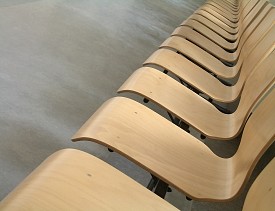Wood Veneers Guide
 Many people have heard the expression that “beauty is only skin deep.” In the world of woodworking and cabinetry, this “beauty” is often a thin layer of wood veneer about 50 thousandths of an inch thick.
Many people have heard the expression that “beauty is only skin deep.” In the world of woodworking and cabinetry, this “beauty” is often a thin layer of wood veneer about 50 thousandths of an inch thick.
Many cabinets are made from veneered stock, be it hardwood plywood, or other veneers laminated to a MDF or man-made core. Higher-end cabinets are often made from a combination of solid wood face-frames and veneered sheet stock for the cabinets' “case."
Veneer can provide a “face lift”
One common approach to updating cabinets is with re-facing. These are the basic types of veneers used for cabinet refacing:
- Raw wood veneer: This group is the most common for the more exotic species of lumber, and is usually the least expensive, although some exotics and rare woods can command some very high prices. Raw wood veneers are simple very thin sheets of wood and are typically limited in size to the boards they are cut from. Finding a 4’ x 8’ sheet of an exotic rosewood veneer in “raw wood” is not going to happen.
- Paper-backed veneer: These are raw wood veneers with paper “backers” applied to the wood. This paper varies in thickness. Two common versions are 10 or 20 mil. backers. Here is it more common to see larger sizes, and full sized sheets of 4 x 8 feet are widely available. The paper backing provides support for the smaller strips to be consolidated into larger sheets. These are also a bit easier to handle, as the fragile nature of the raw wood has been strengthened by the paper. This type is applied with glue.
- PSA Veneers: A fancier version of the paper backed veneers are the PSA types. PSA stands for “pressure sensitive adhesive.” These veneers are also called "peel and stick" veneers. The use of these does not require glues or other complex devices for use. This type is the most common for DIY projects, and can be cut and trimmed with scissors.
- Pre-glued veneers: These may be paper backed or raw wood and have layer of glue pre-applied that is usually heat activated. The most common application for pre-glued veneer is in “edge banding” applications. Here a hot iron is used to “activate” the glue and the veneer is applied while this glue is hot. Upon cooling, the thin veneer layer is firmly bonded to the substrate. Some more modern versions of this are using light in the form of lasers to “activate” this glue.
How to apply veneers
With PSA veneers, application is simple and straight forward: You peel off the backer and stick the veneer onto your substrate. Rollers can be used to reduce bubbles and smooth out the install. Overhanging edges can be trimmed with special edge tools or a simple utility knife.
Paperbacked and raw wood veneers are glued in place. This process can be involved and messy. A vacuum bag or press is often used with smaller applications to provide a “clamp-free” installation. Glues can range from old time hide glues, to modern PVA and contact cement type products. The contact cement applications are handy in that they do not require clamping or “dry” times.
If you are planning to reface some kitchen cabinets, the use of veneers can give an instant updated look. The use of PSA veneer is by far the easiest to work with. A few sheets of this “peel and stick” wood will have your space looking great in no time.
Kevin Stevens is a Networx writer. Read more articles or get help with your home projects on Networx.com.
Looking for a Pro? Call us (866) 441-6648

Remodeling Average Costs
Remodeling Contractors Experiences

Professional Stain Adds The Finishing Touch To My New Cedar Deck

New Stairs And Roof Installation Are The Perfect Deck Upgrade



